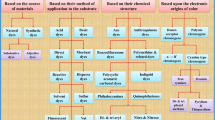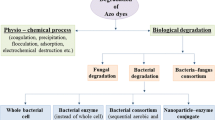Abstract
Industrial effluents carrying dyes are prominent environmental threats to receiving water bodies. Present study related with decolorization of two triphenylmethane (TPM) dyes, i.e., malachite green (MG) and crystal violet (CV), under laboratory settings. Primary screening experiments for dye decolorizing bacteria were performed with ten distinct bacterial isolates on MSM agar supplemented with different conc. of TPM dyes. For secondary screening, decolorization experiments were achieved under submerged fermentative conditions using two halo-thermotolerant bacterial isolates viz. Bacillus subtilis B2d and B. licheniformis B3e strains. Plackett–Burman design for 11 factors (10 numerical plus one categorical) and five internal replicates comprising total 18 experiments was used to screen the most influential parameter affecting decolorization of MG and CV by either bacterial strains. Under optimal fermentation conditions, the bacterial isolate B2d showed significantly higher decolorization than B3e isolate achieving maximum decolorization of MG (72%) and CV (57%). The maximum limits set for the variables like pH, agitation speed, KH2PO4, NaNO3 and yeast extract were found to increase the decolorization rates, whereas the increasing glucose and urea levels negatively affected dye decolorization efficiency of the bacterial isolates. Conclusively, halo-thermotolerant bacterial isolates of present study offer substantial potential for future environmental applications, if favorable conditions provided.




Similar content being viewed by others
References
Ali H (2010) Biodegradation of synthetic dyes—a review. Water Air Soil Pollut 213:251–273
Aubert S, Schwitzguebel J-P (2004) Screening of plant species for the phytotreatment of wastewater containing sulphonated anthraquinones. Water Res 38:3569–3575
Ayed L, Chaieb K, Cheref A, Bakhrouf A (2009) Biodegradation of triphenylmethane dye Malachite Green by Sphingomonas paucimobilis. World J Microb Biot 25:705–711
Banat IM, Nigam P, Singh D, Marchant R (1996) Microbial decolorization of textile-dyecontaining effluents: a review. Bioresour Technol 58:217–227
Cao J, Sanganyado E, Liu W, Zhang W, Liu Y (2019) Decolorization and detoxification of Direct Blue 2B by indigenous bacterial consortium. J Environ Manag 242:229–237
Chang J-S, Chou C, Lin Y-C, Lin P-J, Ho J-Y, Hu TL (2001) Kinetic characteristics of bacterial azo-dye decolorization by Pseudomonas luteola. Water Res 35:2841–2850
Chen K-C, Wu J-Y, Liou D-J, Hwang S-CJ (2003) Decolorization of the textile dyes by newly isolated bacterial strains. J Biotechnol 101:57–68
Chen B-Y, Chen W-M, Wu F-L, Chen P-K, Yen C-Y (2008) Revealing azo-dye decolorization of indigenous Aeromonas hydrophila from fountain spring in Northeast Taiwan. J Chin Inst Chem Eng 39:495–501
Chen B-Y et al (2010) Assessment upon azo dye decolorization and bioelectricity generation by Proteus hauseri. Bioresour Technol 101:4737–4741
Crini G, Lichtfouse E (2019) Advantages and disadvantages of techniques used for wastewater treatment. Environ Chem Lett 17:145–155
Dafale N, Rao NN, Meshram SU, Wate SR (2008) Decolorization of azo dyes and simulated dye bath wastewater using acclimatized microbial consortium–biostimulation and halo tolerance. Bioresour Technol 99:2552–2558
Daneshvar N, Ayazloo M, Khataee A, Pourhassan M (2007) Biological decolorization of dye solution containing Malachite Green by microalgae Cosmarium sp. Bioresour Technol 98:1176–1182
Ghodake GS, Talke AA, Jadhav JP, Govindwar SP (2009) Potential of Brassica juncea in order to treat textile—effluent—contaminated sites. Int J Phytoremediat 11:297–312
Glenn JK, Gold MH (1983) Decolorization of several polymeric dyes by the lignin-degrading basidiomycete Phanerochaete chrysosporium. Appl Environ Microb 45:1741–1747
Guo J, Liu H, Qu J, Lian J, Zhao L, Jefferson W, Yang J (2012) The structure activity relationship of non-dissolved redox mediators during azo dye bio-decolorization processes. Bioresour Technol 112:350–354
Hicham Z, Bencheqroun Z, El Mrabet I, Neves I (2019) Removal of basic dyes from aqueous solutions by adsorption onto Moroccan clay (Fez City). Mediterr J Chem 8:158–167
Jadhav J, Parshetti G, Kalme S, Govindwar S (2007) Decolourization of azo dye methyl red by Saccharomyces cerevisiae MTCC 463. Chemosphere 68:394–400
Jagwani J, Sharma M (2013) COD reduction and biodegradation of textile dye reactive orange M2R by newly isolated bacterial consortium VSS. Int J Environ Ecol Fam Urban Stud 1:69–78
Jones JJ, Falkinham JO (2003) Decolorization of malachite green and crystal violet by waterborne pathogenic mycobacteria. Antimicrob Agents Chemother 47:2323–2326
Kagalkar AN, Jagtap UB, Jadhav JP, Bapat VA, Govindwar SP (2009) Biotechnological strategies for phytoremediation of the sulfonated azo dye Direct Red 5B using Blumea malcolmii Hook. Bioresour Technol 100:4104–4110
Khan R et al (2018) Prokaryotic diversity from extreme environments of Pakistan and its potential applications at regional levels. bioRxiv 342949
Kim MH et al (2008) Structural insight into bioremediation of triphenylmethane dyes by Citrobacter sp triphenylmethane reductase. J Biol Chem 283:31981–31990
Kumar KV, Ramamurthi V, Sivanesan S (2006) Biosorption of malachite green, a cationic dye onto Pithophora sp., a fresh water algae. Dyes Pigments 69:102–107
Leelakriangsak M, Borisut S (2012) Characterization of the decolorizing activity of azo dyes by Bacillus subtilis azoreductase AzoR1. Songklanakarin J Sci Technol 34:509–516
Liu B-L, Tzeng Y-M (1998) Optimization of growth medium for the production of spores from Bacillus thuringiensis using response surface methodology. Bioprocess Eng 18:413–418
Mabrouk MEM, Yusef HH (2008) Decolorization of fast red by Bacillus subtilis HM. J Appl Sci Res 4:262–269
Mahmood R, Sharif F, Ali S, Hayyat MU (2015) Enhancing the decolorizing and degradation ability of bacterial consortium isolated from textile effluent affected area and its application on seed germination. Sci World J. https://doi.org/10.1155/2015/628195
Maier J, Kandelbauer A, Erlacher A, Cavaco-Paulo A, Gübitz GM (2004) A new alkali-thermostable azoreductase from Bacillus sp. strain SF. Appl Environ Microbiol 70:837–844
Micheal K, Ayeshamariam A, Devanesan S, Bhuvaneswari K, Pazhanivel T, AlSalhi MS, Aljaafreh MJ (2020) Environmental friendly synthesis of carbon nanoplates supported ZnO nanorods for enhanced degradation of dyes and organic pollutants with visible light driven photocatalytic performance. J King Saud Univ Sci 32:1081–1087
Myers RH, Montgomery DC, Anderson-Cook CM (2016) Response surface methodology: process and product optimization using designed experiments. Wiley
Nanthakumar K, Karthikeyan K, Suriyanarayanan S, Lakshmanaperumalsamy P (2013) Application of Plackett-Burman design to optimize bioprocess variables for decolorization of Reactive Red 195 by a Termite Associated Bacterial Consortium BUTC7. In: Velu RK (ed) Microbiological research in agroecosystem management. Springer India, India, pp 23–34. https://doi.org/10.1007/978-81-322-1087-0_3
Nerurkar AS (2013) Characterization of a methylotrophic bacterial consortium and its potential in treatment of industrial effluents. Maharaja Sayajirao University of Baroda
Palani VR, Rajakumar S, Ayyasamy PM (2012) Exploration of promising dye decolorizing bacterial strains obtained from Erode and Tiruppur textile wastes. Int J Environ Sci 2:2470–2481
Pandey A, Singh P, Iyengar L (2007) Bacterial decolorization and degradation of azo dyes. Int Biodeter Biodegrad 59:73–84
Parshetti G, Kalme S, Saratale G, Govindwar S (2006) Biodegradation of malachite green by Kocuria rosea MTCC 1532. Acta Chim Slov 53:492
Patel AK, Chaudhary HH, Patel KS, Sen DJ (2014) Colour of ecofriendly dyes used in Holi rather than triphenyl methane dyes Int. J Pharm Pharm Sci 3:1287–1305
Ponraj M, Gokila K, Zambare V (2011) Bacterial decolorization of textile dye-Orange 3R. Int J Adv Biotechnol Res 2:168–177
Prasad A, Rao KVB (2011) Physicochemical analysis of textile effluent and decolorization of textile azo dye by Bacillus endophyticus strain VITABR13. IIOAB J 2:55–62
Rao N, Bose G, Khare P, Kaul S (2006) Fenton and electro-Fenton methods for oxidation of H-acid and Reactive Black 5. J Environ Eng 132:367–376
Robinson T, McMullan G, Marchant R, Nigam P (2001) Remediation of dyes in textile effluent: a critical review on current treatment technologies with a proposed alternative. Bioresour Technol 77:247–255
Saharan BS, Ranga P (2010) Enhanced decolourization of congo red dye under submerged fermentation (SMF) process by newly isolated Bacillus subtilis SPR42. J Nat Appl Sci 3:51–53
Sani RK, Banerjee UC (1999) Decolorization of triphenylmethane dyes and textile and dye-stuff effluent by Kurthia sp. Enzyme Microb Technol 24:433–437
Saratale R, Saratale G, Kalyani D, Chang J-S, Govindwar S (2009) Enhanced decolorization and biodegradation of textile azo dye Scarlet R by using developed microbial consortium-GR. Bioresour Technol 100:2493–2500
Saratale RG, Saratale G, Chang J, Govindwar S (2011) Bacterial decolorization and degradation of azo dyes: a review. J Taiwan Inst Chem E 42:138–157
Sharma D, Saini H, Singh M, Chimni S, Chadha B (2004) Biodegradation of acid blue-15, a textile dye, by an up-flow immobilized cell bioreactor. J Ind Microbiol Biotehnol 31:109–114
Thangavel AK, Subbaian K (2013) Biodegradation of Azo dye using Bacillus flexus Malaya. J Biosci 1:46–48
Tripathi A, Srivastava SK (2011) Ecofriendly treatment of azo dyes: biodecolorization using bacterial strains. Int J Biosci Biochem Bioinform 1:37
Varjani S, Rakholiya P, Ng HY, You S, Teixeira JA (2020) Microbial degradation of dyes: an overview. Bioresour Technol 314:123728
Vasdev K (2012) Decolorization of triphenylmethane dyes by six white-rot fungi isolated from nature. J Bioremediat Biodegrad 2(128):1–5. https://doi.org/10.4172/2155-6199.1000128
Verma P, Madamwar D (2002) Comparative study on transformation of azo dyes by different white rot fungi Indian. J Biotechnol 1:393–396
Wang H, Su JQ, Zheng XW, Tian Y, Xiong XJ, Zheng TL (2009) Bacterial decolorization and degradation of the reactive dye Reactive Red 180 by Citrobacter sp. CK3. Int Biodeter Biodegrad 63:395–399
Weisburger JH (2002) Comments on the history and importance of aromatic and heterocyclic amines in public health. Mutat Res 506:9–20
Willmott N, Guthrie J, Nelson G (1998) The biotechnology approach to colour removal from textile effluent. J Soc Dyers Colour 114:38–41
Wuhrmann K, Mechsner KL, Kappeler TH (1980) Investigation on rate—determining factors in the microbial reduction of azo dyes. Eur J Appl Microbiol 9:325–338
Acknowledgements
The authors are extremely thankful for the support of the Higher Education Commission (HEC), Government of Pakistan for funding this research under Start-up Research Grant program to the principle investigators.
Author information
Authors and Affiliations
Corresponding author
Ethics declarations
Conflict of interest
The authors declare that they have no conflict of interest.
Additional information
Editorial responsibility: Sivakumar Durairaj.
Rights and permissions
About this article
Cite this article
Jakhrani, B.A., Phulpoto, I.A., Phulpoto, A.H. et al. Improved decolorization of triphenylmethane dyes by halo-thermotolerant bacteria isolated from hypersaline environments. Int. J. Environ. Sci. Technol. 19, 3261–3274 (2022). https://doi.org/10.1007/s13762-021-03320-3
Received:
Revised:
Accepted:
Published:
Issue Date:
DOI: https://doi.org/10.1007/s13762-021-03320-3




